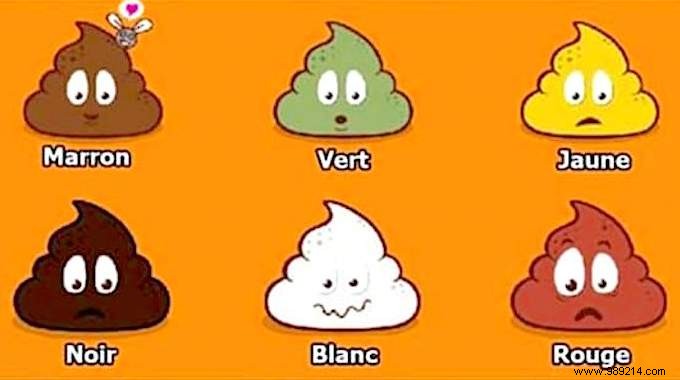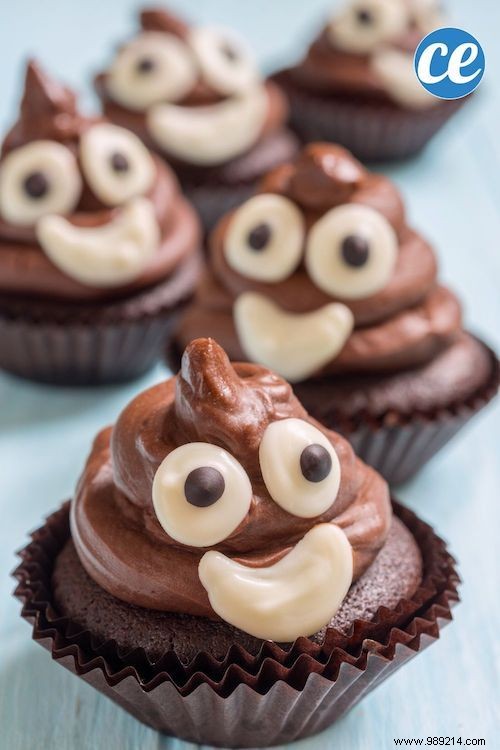
Everyone is pooping. For some, defecating is a necessary evil.
For others, it's a pleasant step in the digestive process.
Of course, the expulsion of feces may not be the most glamorous subject to shine in society...
Still, there's no shame in educating yourself about all the things poop can tell you about your health!
What's the harm in knowing what your poo says about your health ? It's simply a better understanding of how your body works!
Here's everything your poop says about your health based on its color, shape, and texture:

Click here to easily print this guide in PDF.
Meaning: in the colon, the stools lack water and become very hard and difficult to pass. It is a sign of constipation or an undesirable effect of certain medications.
Processing: drink more water and eat more fiber. If you are on antibiotic treatment, consume more probiotics to stimulate the intestinal flora. To promote intestinal transit, go for a walk or another moderate physical activity.
Meaning: the stools lack water and are moderately hard to pass. This type is frequently associated with constipation.
Processing: as shown above.
Meaning: stools are normal, maybe slightly too hard.
Processing: no special treatment. To make stools softer and easier to pass, drink more water and eat more fiber. If your intestinal transit slows down, you risk having a type 2 stool.
Meaning: the perfect poo!
Processing: no treatment necessary.
Meaning: the stools are normal.
Processing: no treatment necessary.
Meaning: stool malabsorption due to too rapid intestinal transit. Indicates possible diarrhea, possibly due to foodborne infection.
Processing: To avoid dehydration, drink plenty of water. Consult a doctor if this change persists for more than 2 days.
Meaning: the water is not reabsorbed by the intestines:this is diarrhea. Due to infection or inflammation of the intestines, food intolerance, or irritable bowel syndrome (IBS).
Processing: the risk of dehydration is very high. So, drink plenty of fluids. To compensate for the loss of electrolytes, take oral rehydration solution (ORS). Consult a doctor if dehydration persists for more than a day.
Our excrement is mainly composed of undigested food, proteins, bacteria, salts and substances produced and released by the intestines.
Stools can vary in size, shape, and smell, but certain elements are a sign of good (or bad) health.

First of all, you should know that the appearance of healthy poop can vary from person to person!
To take a closer look at your production and learn more about your state of health, here is the basics of poo:its color, shape, size and texture .
You know the poo emoji, the one that represents a pile of feces?
Well, this symbol hits the bullseye on one of the most important characteristics of healthy poop!
In a healthy person, the stools have a brownish color – neither too light nor too dark.
It is bilirubin, a reddish pigment produced by the body during the breakdown of red blood cells, which gives this brown color to the turds.
It is inside the winding walls of the intestines that stool is formed.
Therefore, a perfect poop has a streamlined and elongated shape , like a smooth sausage.
But as you will see below, stool can come in different forms, depending on how long it has been in the colon.
So if your poop is NOT the elongated shape of a sausage, your poo is telling you something is wrong!

If all goes well, your poo doesn't come out in small pieces (we cover this topic below).
Ideally, the saddles are about 5 cm in length and are easy to evacuate .
Healthy poop is neither too soft nor too firm , while maintaining a compact shape that does not fall apart.
If it is too dry or too watery, it indicates digestive disorders or a fiber deficiency.
To discover: The 16 Highest Fiber Foods You Should Know.

When a person spends too much time in the bathroom, it is often assumed that they have to do the big errand.
However, be aware that a healthy poo is easy to evacuate, and takes no more than 1 min to expel .
That said, some people tend to take a little longer to relieve themselves.
So, as a general rule, a normal poop takes no more than 10-15 min.
If you take longer, there is a small constipation problem. In this case, I recommend this effective and natural remedy.

This visual scale is based on a University of Bristol study of different stool shapes and textures in over 2,000 people.
The Bristol Scale divides stools into 7 types.
This is by far the easiest and most effective tool to help you understand what your poop is saying about your health.
Description: small, hard, loose, nut-like droppings that are difficult to pass
Meaning: this type of stool usually indicates constipation. It is uncommon in people who have a normal intestinal transit.
Description: same shape as Type 1, but the small balls of poop are aggregated into a sausage shape.
Meaning: also indicates constipation. Again, this guy is unusual.
Description: sausage-shaped with small cracks on the surface.
Meaning: the ideal turd! This is the goal to achieve, provided it is a little soft and easy to expel.
Description: smooth and sausage or snake-shaped, and easy to expel.
Meaning: according to doctors, it is also a healthy and normal poop. It should occur every 1-3 days.
Description: stools come out in small lumps, as with type 1, but very soft and easy to pass. They are irregular in shape with well-defined contours.
Meaning: indicates that you are not eating enough fiber. It's time to eat more grains and vegetables.
Description: small frothy pieces with irregular contours.
Meaning: an excessively soft texture is a sign of mild diarrhea. To regain normal transit, drink more water and fruit juice.
Description: the stools are entirely liquid and without any solid lumps.
Meaning: it's diarrhea. In other words, the intestinal transit is too fast, and the intestines cannot transform food into healthy and normal poo.

As with size and texture, the different colors of your stool can also tell you about your health status.
And as mentioned above, normal stool color is brown , in all its nuances.
Be aware that stool color can also be green in healthy people, according to medical experts.
On the other hand, if the color of your poop tends towards white, black, red, yellow-orange or one of the other colors of the rainbow, then it is better to consult a doctor.
Black stools can be the result of certain medications or treatment for iron deficiency, but also from excessive consumption of licorice.
If not, black stools indicate presence of blood in the digestive tract.
But then, why this black color if the blood is red? Upstream, the blood has been partly digested by the intestinal flora, which produces very black stools.
As mentioned earlier, stools that are slightly green in color are completely normal.
But if your stool turns completely green, there are 2 possible explanations:
- either you have eaten a lot of green foods, such as spinach,
- either your green stools are a sign of too rapid transit, due to gastroenteritis or diarrhea, for example.
When bilirubin does not have time to be broken down by the intestinal flora, it contains more bile salts, which gives it a greenish color.
Whitish stools are usually a sign of a defect in the flow of bile in the intestine.
Bile is a greenish-yellow digestive fluid, secreted by the liver and stored in the gallbladder.
So, if your stools have a whitish color, it probably means that your bile ducts are blocked.
Whitish stools are also an undesirable effect of certain medications, especially anti-diarrhea. In any case, it is better to consult a doctor.
As you may have guessed, red stools are a potential sign of bleeding, either in the digestive tract or from hemorrhoids.
But before you panic because your stools are red, first think about what you ate!
Indeed, certain foods can change the color of stools to red:this is particularly the case with beets, cranberries, tomato juice or even red gelatin.
Stools can also be yellow-orange, with a particularly foul odor and greasy appearance.
This is often due to poor fat digestion and may indicate a nutrient malabsorption disorder, such as celiac disease (gluten intolerance).
Normally, in a healthy person, the stool should flow .
But sometimes, looking in the toilet bowl, it happens that we notice stools that float, like a little duck in a bathtub.
If your poo floats, don't worry, it's usually not serious.
It just means that some of your saddles are less dense than others, which tend to sink like the Titanic!
In a study of stools that float, researchers have found that this lack of density indicates excess gas or water in the feces.
Another possible explanation behind the floating poop mystery is poor nutrient absorption.
If so, it likely indicates one of the previously mentioned abnormalities, such as mild constipation.

Many people think know what constipation is.
But according to medical experts, you can only talk about constipation when you have a bowel movement less than 3 times a week .
If you are not having a bowel movement, there are several possible explanations.
For example, it may be due to a disorder of the nerves that regulate the intestines, colon and rectum.
Similarly, disorders of the pelvic floor muscles (the perineum) can also slow down your intestinal transit.
Constipation is also a common annoyance of pregnancy, diabetes and many hormonal diseases.
But then what if you feel a blockage or have trouble having a bowel movement?
To fight against constipation, consider increasing your consumption of fiber-rich foods:for example, raw vegetables, pulses, fruits (the famous prunes!) and whole grains.
Also remember to drink plenty of water, exercise and reduce your stress levels.
To discover: The 11 Natural Remedies To Know For Constipation.

If your poo is out of the ordinary and it persists for more than 2 days, it's best to talk to a healthcare professional.
Doing a green poo here or a hard poo there, it can happen to anyone…
But if these changes in your usual transit persist for more than a day or two, it means it's time to see a doctor.
This also applies to less alarming changes, such as variations in the color or texture of your stool, but also constipation.
Even more serious, the chronic constipation , which can block your intestines, and chronic diarrhea which prevent the intestines from absorbing the nutrients necessary for a healthy diet.
Also, be aware that chronic constipation or chronic diarrhea can potentially be a sign of a serious illness.
But again, that doesn't mean you should be alarmed as soon as your poop is out of the ordinary!
Wait to see if the symptoms of unusual poop persist. And if it lasts more than a few days, then go see a doctor.
An exception to the rule:if there is blood in your stool. If you have not eaten any of the foods that can cause red color then it is important to seek medical attention immediately.
Many people do not attach any importance to their saddles. Still, your poo can tell a lot about your health.
So the next time you have a bowel movement, take a moment and look down the toilet before you flush.
You can surely learn a lot about your state of health.
